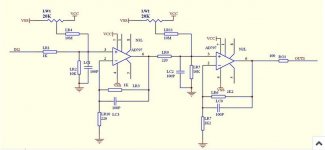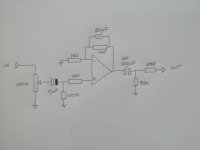I keep reading about how difficult the AD797 is to use and how easily it oscillates.
I've been trying to use it for a simple linestage with a gain of only 2. I've been using 1K ohm resistors for both the feedback and feedback shunt like shown in the Analog data sheet. I have not tried adding the 20pF caps across the feedback resistors.
The issue I'm having is what sounds like "static" as I turn the 100K ohm volume pot which I have directly connected through a 1K ohm resistor to the noninverting inputs of the 797.
When I measure the DC offset at the 797's outputs, I get anywhere from -9mV to just a few tenths as I turn the volume pot.
I thought this type of problem is usually caused from using op-amps with high input bias currents or current-feedback type op-amps.
So I came across this board that uses the AD797 and has provisions for a volume pot:
MBL6010D 10 Times Hi End AD797 Preamplifier Kit WLX | eBay
I'm not sure why anyone would need 2 gain stages, but that's the way it's set up.
So I have a few questions about this design:
1) What's the purpose of the 20K ohm pots and 10M ohm resistors? Is this some type of DC servo to balance the inputs of the op-amp?
2) Would I have to implement something like this in order to get rid of the "static" I hear when turning the volume control?
3) Does this circuit look like it work as is or are there some things that you guys would change?
Thank you...
Here's the schematic the seller provides:
I've been trying to use it for a simple linestage with a gain of only 2. I've been using 1K ohm resistors for both the feedback and feedback shunt like shown in the Analog data sheet. I have not tried adding the 20pF caps across the feedback resistors.
The issue I'm having is what sounds like "static" as I turn the 100K ohm volume pot which I have directly connected through a 1K ohm resistor to the noninverting inputs of the 797.
When I measure the DC offset at the 797's outputs, I get anywhere from -9mV to just a few tenths as I turn the volume pot.
I thought this type of problem is usually caused from using op-amps with high input bias currents or current-feedback type op-amps.
So I came across this board that uses the AD797 and has provisions for a volume pot:
MBL6010D 10 Times Hi End AD797 Preamplifier Kit WLX | eBay
I'm not sure why anyone would need 2 gain stages, but that's the way it's set up.
So I have a few questions about this design:
1) What's the purpose of the 20K ohm pots and 10M ohm resistors? Is this some type of DC servo to balance the inputs of the op-amp?
2) Would I have to implement something like this in order to get rid of the "static" I hear when turning the volume control?
3) Does this circuit look like it work as is or are there some things that you guys would change?
Thank you...
Here's the schematic the seller provides:
Attachments
the circuit shown seems to be injecting DC correction with the pots
the AD797 datasheet specifies minimum R in series with the inputs for stability at low gains
in addition to the feedback network Z seen at the - input I would add a Zobel series RC to gnd at the + input
don't use a feedback cap for AV=2 - do read the datasheet closely for "unity gain" minimum required R, don't forget the need for supurb RF gnd and PS bypass at the op amp pins - planes, smt caps are your friend
also reading up on "noise gain compensation - a technique that can help taming these marginal, not quite "unity gain stable" op amps
the AD797 datasheet specifies minimum R in series with the inputs for stability at low gains
in addition to the feedback network Z seen at the - input I would add a Zobel series RC to gnd at the + input
don't use a feedback cap for AV=2 - do read the datasheet closely for "unity gain" minimum required R, don't forget the need for supurb RF gnd and PS bypass at the op amp pins - planes, smt caps are your friend
also reading up on "noise gain compensation - a technique that can help taming these marginal, not quite "unity gain stable" op amps
Last edited:
and of course the AD797 is wasted with a typical audio volume pot presenting too high input Z that gives more noise with the heavy bias bjt input i_noise
the low Vnoise of the 797 doesn't come into play until Rsource is < 500 Ohms
the low Vnoise of the 797 doesn't come into play until Rsource is < 500 Ohms
All the time you allow DC to flow through a volume pot you are likely to have noise when you turn the pot . In your case it is due to the non inverting input bias current flowing through the pot , as demonstrated by the varying DC offset as you turn said pot.
The circuit you posted still has the potential to put DC through your pot .
The circuit you posted still has the potential to put DC through your pot .
OK, so putting a pot in front of a 797 sounds like a bad idea with the high input bias current(I understand this is common with bipolar op-amps) and because of the high impedances that will be at the outputs of a volume pot.
This must be why I can't find any schematics that show such a configuration.
So where in a audio circuit CAN a 797 be implemented successfully?
This must be why I can't find any schematics that show such a configuration.
So where in a audio circuit CAN a 797 be implemented successfully?
why not just block the DC from going through the pot by using a capacitor in series with the wiper and then bias the non inverting input with a 100K resistor to ground.
low Z home audio source would be mostly MC phono cart, some audio DAC outputs
noise current is AC, still creates Vnoise with high source Z even if AC coupled
noise current is AC, still creates Vnoise with high source Z even if AC coupled
Last edited:
why not just block the DC from going through the pot by using a capacitor in series with the wiper and then bias the non inverting input with a 100K resistor to ground.
I didn't know you could do that. That's why I'm asking questions here on this forum.
So would the capacitors go before or after the 1K ohm resistors that are in series with the noninverting inputs?
What size cap...like 2.2uF or something larger?
The 10uF and 100uF capacitors would ideally be non polarised electrolytic and the pot would preferably be 10K .
Attachments
Last edited:
10k gives 2.5 kOhm mid point setting Z - the AD797 i_noise then contributes ~5 nV/sqrt(Hz)
you do have to look hard to find a low v_noise in FET input op amp - a possibility would be to parallel all 4 OPA1644 in the quad package
though going to that extreme only gives ~ 1.4 dB noise figure improvement over using the AD797 with the 10k pot's ~6.6 nV/sqrt(Hz) midpoint setting thermal noise
you do have to look hard to find a low v_noise in FET input op amp - a possibility would be to parallel all 4 OPA1644 in the quad package
though going to that extreme only gives ~ 1.4 dB noise figure improvement over using the AD797 with the 10k pot's ~6.6 nV/sqrt(Hz) midpoint setting thermal noise
- Status
- Not open for further replies.
- Home
- Amplifiers
- Solid State
- Using the AD797 with a volume pot...

